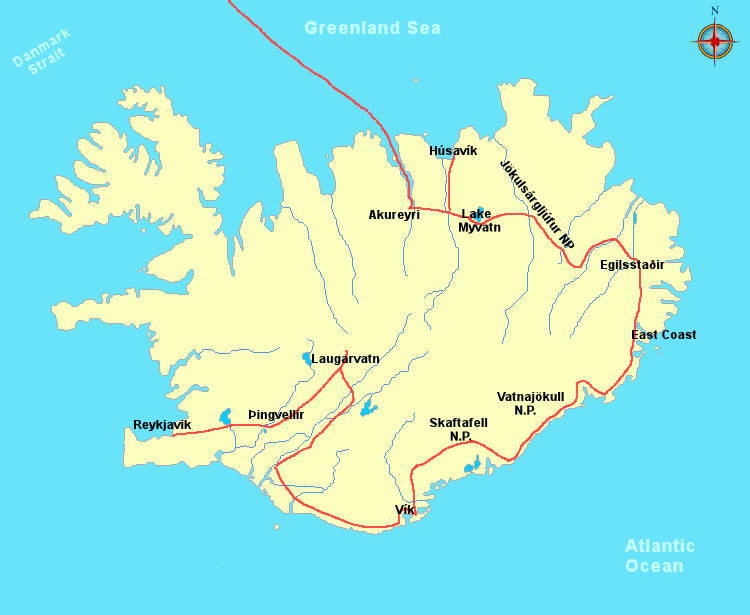Iceland

Historie
According to the Landnámabók ("Book of Settlements"), in the ninth century AD Iceland was discovered by
Naddodd, one of the first settlers in the Faroe Islands, who was sailing from Norway to the Faroes but lost his
way and drifted to the east coast of Iceland. Naddodd called the country Snæland "Snowland".
Swedish sailor Garðar Svavarsson also accidentally drifted to the coast of Iceland. He discovered that the country
was an island and called it Garðarshólmi "Garðar's Islet" and stayed for the winter at Húsavík.
The first Norseman who deliberately sailed to Garðarshólmi was Hrafna-Flóki Vilgerðarson. Flóki settled for one winter
at Barðaströnd. After the cold winter passed, the summer came and the whole island became green, which stunned Flóki.
Realizing that this place was in fact habitable, despite the horribly cold winter, and full of useful resources,
Flóki restocked his boat.
The first known permanent Norse settler was Ingólfur Arnarson, who built his homestead in present-day Reykjavík
in the year 874. Ingólfr was followed by many other emigrant settlers, largely Norsemen and their "thralls", many of whom
were Irish or Scottish.
By 930, most arable land had been claimed and the Althing, a legislative and judiciary parliament, was initiated to
regulate the Icelandic Commonwealth.
The internal struggles and civil strife of the Sturlung Era led to the signing of the Old Covenant in 1262,
which ended the Commonwealth and brought Iceland under the Norwegian crown. Possession of Iceland passed to
Kalmar Union in 1415, when the kingdoms of Norway, Denmark and Sweden were united. After the break-up of the
union in 1523, it technically remained a Norwegian dependency, as a part of Denmark-Norway (1536-1814).
English and German merchants became more prominent in Iceland at the start of the 15th century. Some historians refer to
the 15th century as the "English Age" in Iceland's history, due to the prominence of English traders and fishing
fleets. What drew foreigners to Iceland was primarily fishing in the fruitful waters off the coast of Iceland.
The 16th century has been referred to as the "German Age" by Icelandic historians due to the prominence of German
traders. The Germans did not engage in much fishing themselves, but they owned fishing boats, rented them to Icelanders and
then bought the fish from Icelandic fishermen to export to the European Continent.
In 1602, Iceland was forbidden to trade with countries other than Denmark, by order of the Danish government, which at this time
pursued mercantilist policies. The Danish–Icelandic Trade Monopoly remained in effect until 1786.
In 1814, following the Napoleonic Wars, Denmark-Norway was broken up into two separate kingdoms via the Treaty of
Kiel. Iceland, however, remained a Danish dependency.
An independence movement developed under the leadership of a lawyer named Jón Sigurðsson. In 1843, a new Althing
was founded as a consultative assembly. It claimed continuity with the Althing of the Icelandic Commonwealth, which had remained
for centuries as a judicial body and had been abolished in 1800.
In 1874, Denmark granted Iceland a constitution and "home rule", which again was expanded in 1904. The constitution
was revised in 1903, and a minister for Icelandic affairs, residing in Reykjavík, was made responsible to the Althing, the
first of whom was Hannes Hafstein.
The Danish–Icelandic Act of Union, an agreement signed by Iceland and Denmark on 1 December 1918, recognized Iceland as
a fully sovereign state — the Kingdom of Iceland — joined with Denmark in a personal union with the Danish king. Iceland
established its own flag. Denmark was to represent its foreign affairs and defense interests.
On 31 December 1943, the Act of Union agreement expired after 25 years. Beginning on 20 May 1944, Icelanders voted in a four-day
plebiscite on whether to terminate the personal union with the King of Denmark and establish a republic. The vote was 97% in favour
of ending the union and 95% in favour of the new republican constitution. Iceland became an independent republic on
17 June 1944, with Sveinn Björnsson as its first president.
Iceland became a charter member of the North Atlantic Treaty Organization (NATO) on 30 March 1949, with the reservation
that it would never take part in offensive action against another nation.
I have visitted Iceland in september 2013
These are the places i have been in Iceland
Akureyri
Húsavík
Lake Myvatn
Jökulsárgljúfur National Park
Egilsstaðir
East Coast
Vatnajökull National Park
Skaftafell National Park
Vík
Laugarvatn
Þingvellir
Reykjavik
Please let me know when you're having questions.
i would be pleased to help you.
Things to do and other tips
